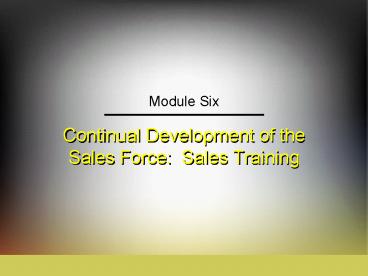Continual Development of the Sales Force: Sales Training
1 / 26
Title:
Continual Development of the Sales Force: Sales Training
Description:
Describe the sales training process is a series of six interrelated steps. ... Identify the key issues in evaluating sales training alternates. ... – PowerPoint PPT presentation
Number of Views:111
Avg rating:3.0/5.0
Title: Continual Development of the Sales Force: Sales Training
1
Continual Development of theSales Force Sales
Training
- Module Six
2
Learning Objectives
- Understand the role of sales training in sales
for socialization. - Explain the importance of sales training in the
sales managers role in sales training. - Describe the sales training process is a series
of six interrelated steps. - Discuss six methods for assessing sales training
needs and identify typical sales training needs.
3
Learning Objectives
- Name some typical objectives of sales training
programs, and explain how city objectives for
sales training is beneficial to sales managers. - Identify the key issues in evaluating sales
training alternates. - Identify key Africa legal issues and sales
training.
4
Setting the Stage
Sales Training at UPS from Selling Rates to
Selling Solutions
- What are the three objectives UPS hopes to
accomplish with its new training program? - Why does UPS spend more money to bring
salespeople to the training? What activities do
UPS salespeople do during training?
5
Role of Sales Training inSales Force
Socialization
6
Sales Training as a Crucial Investment
- Most organizations see a link between sales
training and salesperson productivity - U.S. companies spend approximately 8.7 billion
annually on training - The need for sales training is continual
- Sales managers play a crucial role in the
training process
7
Managing the Sales Training Process
8
Assess Training Needs
- Determine desired skill set and levels of
performance - Assess salespersons actual skill set and levels
of performance - Analyze gap between desired and actual to
determine training needs
9
Assess Training Needs Methods
- Sales Force Audit
- Performance Testing
- Observation
- Salesforce Survey
- Customer Survey
- Job analysis
10
Typical Sales Training Needs
- Sales TechniquesSalespeople have an ongoing
need to learn how to sell - Product KnowledgeSalespeople must know their
product benefits, applications, competitive
strengths, and limitations
11
Typical Sales Training Needs
- Customer KnowledgeSalespeople should know their
customer needs, buying motives, buying
procedures, and personalities. - Competitive KnowledgeSalespeople must know
competitive offerings in terms of strengths and
weaknesses.
12
Typical Sales Training Needs
- Time and Territory Management Salespeople should
learn to maximum work efficiency.
13
Competencies ofSuccessful Salespeople
- Aligning customer/supplier strategic objectives
- Listening beyond product needs
- Understanding the financial impact of decisions
- Orchestrating organizational resources
- Consultative problem solving
14
Competencies ofSuccessful Salespeople
- Establishing a vision of a committed
customer/supplier relationship - Engaging in self-appraisal and continuous learning
15
Common MistakesSales Training Addresses
- Ineffective listening and questioning
- Failure to build rapport and trust
- Poor job of prospecting for new accounts
- Lack of preplanning of sales calls
- Reluctance to make cold calls(without an
appointment)
16
Common MistakesSales Training Addresses
- Lack of sales strategies for different accounts
- Failure to match call frequency with account
potential - Spending too much time with old customers
17
Common MistakesSales Training Addresses
- Over-controlling the sales call
- Failure to respond to customers needs with
benefits - Giving benefits before clarifying customers
needs - Ineffective handling of negative attitudes
- Failure to effectively confirm the sale
18
Training Objectives
- Increase sales or profits
- Create positive attitudes and improve salesforce
morale - Assist in sales force socialization
- Reduce role conflict and ambiguity
19
Training Objectives
- Introduce new products, markets, and promotional
programs - Develop salespeople for future management
positions - Ensure awareness of ethical and legal
responsibilities
20
Training Objectives
- Teach administrative procedures
- Ensure competence in the use of sales and sales
support tools - Minimize sales force turnover rate
- Prepare new salespeople for assignment to a sales
territory - Improve teamwork cooperative efforts
21
Evaluate Training Alternatives
- Selecting Sales Trainers
- Internal
- External
- Selecting Sales Training Locations
- Decentralized (e.g., district or regional
offices) - Centralized (e.g., corporate headquarter)
22
Evaluate Training Alternatives
- Selecting Sales Training Methods
- Classroom/Conference Training
- On-the-job Training (OJT)
- Mentoring
- Job rotation
23
Evaluate Training Alternatives
- Selecting Sales Training Methods
- Behavioral Simulations
- Absorption Training
- Selecting Sales Training Media
- Internet
- Computer-Based (e.g., CD-ROM)
- Paper-Based
24
Design the Sales Training Program
- Finalize the Training Program
- Schedule Training Sessions
- Make Necessary Travel Arrangements
- Make Necessary Accommodation Arrangements
25
Perform Sales Training
As the training is being conducted, the sales
managers primary responsibility is to monitor
progress of the trainees and to ensure adequate
presentation of the training topics.
26
Conduct Follow-Up and Evaluation
It is always difficult to measure the
effectiveness of sales training. Nevertheless, a
reasonable attempt must be made to assess whether
current training expenditures are worthwhile and
whether future modification is warranted.































